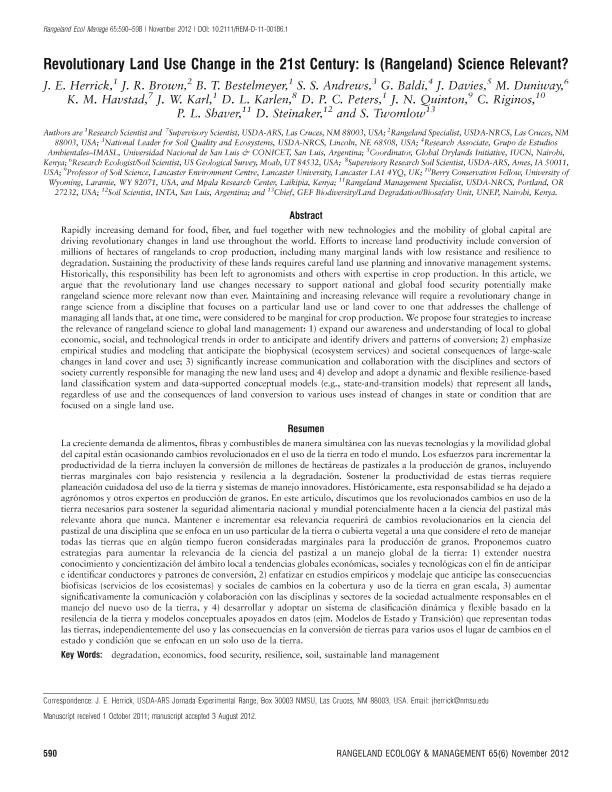Artículo
Revolutionary Land Use Change in the 21st Century: Is (Rangeland) Science Relevant?
Herrick, J. E.; Brown, J. R.; Bestelmeyer, B. T.; Andrews, S. S.; Baldi, Germán ; Davies, J.; Duniway, M.; Havstad, K. M.; Karl, J. W.; Karlen, D. L.; Peters, D. P. C.; Quinton, J. N.; Riginos, C.; Shaver, P. L.; Steinaker, D.; Twomlow, S.
; Davies, J.; Duniway, M.; Havstad, K. M.; Karl, J. W.; Karlen, D. L.; Peters, D. P. C.; Quinton, J. N.; Riginos, C.; Shaver, P. L.; Steinaker, D.; Twomlow, S.
 ; Davies, J.; Duniway, M.; Havstad, K. M.; Karl, J. W.; Karlen, D. L.; Peters, D. P. C.; Quinton, J. N.; Riginos, C.; Shaver, P. L.; Steinaker, D.; Twomlow, S.
; Davies, J.; Duniway, M.; Havstad, K. M.; Karl, J. W.; Karlen, D. L.; Peters, D. P. C.; Quinton, J. N.; Riginos, C.; Shaver, P. L.; Steinaker, D.; Twomlow, S.
Fecha de publicación:
11/2012
Editorial:
Society For Range Management
Revista:
Rangeland Ecology And Management
ISSN:
1550-7424
Idioma:
Inglés
Tipo de recurso:
Artículo publicado
Clasificación temática:
Resumen
Rapidly increasing demand for food, fiber, and fuel together with new technologies and the mobility of global capital are driving revolutionary changes in land use throughout the world. Efforts to increase land productivity include conversion of millions of hectares of rangelands to crop production, including many marginal lands with low resistance and resilience to<br />degradation. Sustaining the productivity of these lands requires careful land use planning and innovative management systems. Historically, this responsibility has been left to agronomists and others with expertise in crop production. In this article, we argue that the revolutionary land use changes necessary to support national and global food security potentially make<br />rangeland science more relevant now than ever. Maintaining and increasing relevance will require a revolutionary change in range science from a discipline that focuses on a particular land use or land cover to one that addresses the challenge of managing all lands that, at one time, were considered to be marginal for crop production. We propose four strategies to increase the relevance of rangeland science to global land management: 1) expand our awareness and understanding of local to global economic, social, and technological trends in order to anticipate and identify drivers and patterns of conversion; 2) emphasize empirical studies and modeling that anticipate the biophysical (ecosystem services) and societal consequences of large-scale changes in land cover and use; 3) significantly increase communication and collaboration with the disciplines and sectors of society currently responsible for managing the new land uses; and 4) develop and adopt a dynamic and flexible resilience-based land classification system and data-supported conceptual models (e.g., state-and-transition models) that represent all lands, regardless of use and the consequences of land conversion to various uses instead of changes in state or condition that are focused on a single land use.
Palabras clave:
Degradation
,
Economics
,
Food Security
,
Resilience
,
Soil
,
Sustainable Land Management
Archivos asociados
Licencia
Identificadores
Colecciones
Articulos(IMASL)
Articulos de INST. DE MATEMATICA APLICADA DE SAN LUIS
Articulos de INST. DE MATEMATICA APLICADA DE SAN LUIS
Citación
Herrick, J. E.; Brown, J. R.; Bestelmeyer, B. T.; Andrews, S. S.; Baldi, Germán; et al.; Revolutionary Land Use Change in the 21st Century: Is (Rangeland) Science Relevant?; Society For Range Management; Rangeland Ecology And Management; 65; 6; 11-2012; 590-598
Compartir
Altmétricas



